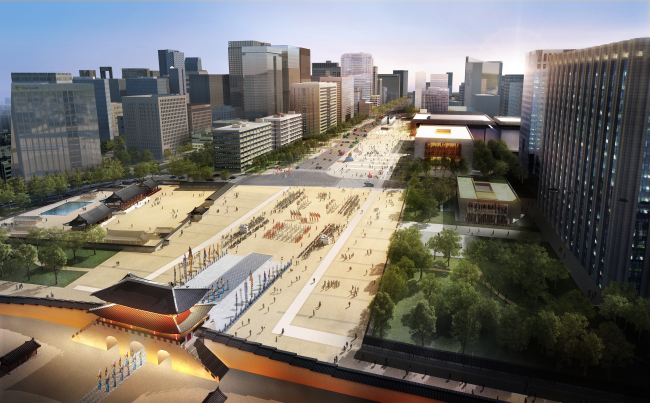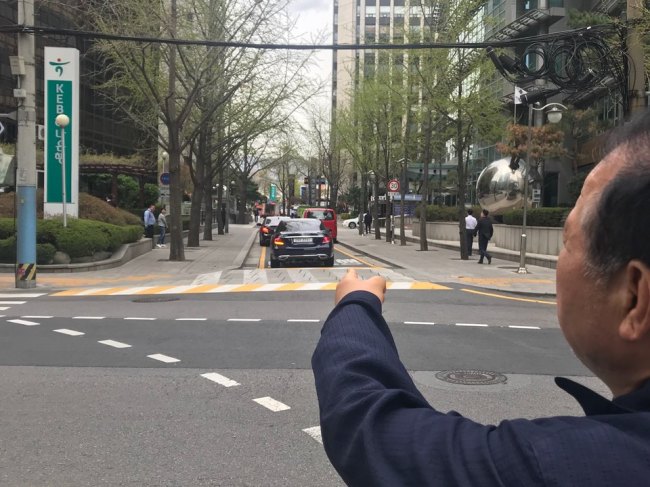[Newsmaker] Residents slam $93m project to expand Gwanghwamun Square
By Bak Se-hwanPublished : April 10, 2018 - 18:26
Gwanghwamun Square in Seoul is where South Korea’s largest political protests take place. The 2017 massive candlelight vigils here led to the impeachment of the former President Park Geun-hye last year.
For many, Seoul’s symbolic center represents the nation’s passion for democracy and freedom of expression -- at least for people who don’t live in the area.
For many, Seoul’s symbolic center represents the nation’s passion for democracy and freedom of expression -- at least for people who don’t live in the area.

But local residents find the place to be full of air and noise pollution, with heavy traffic that passes through the intersections and protesters shouting their slogans. Police lining the streets to control demonstrations are another inconvenience to those who live in nearby apartment complexes have to put up with every weekend.
So when Seoul Mayor Park Won-soon announced Tuesday that Sejongno would be reduced from the 10 lanes to 6 lanes to expand Gwangwhamun Square, it received a scathing reception from both residents and office workers in the area.
In a joint effort between Seoul Metropolitan Government and the Cultural Heritage Administration, the new square, to be completed by 2021, will be expanded to encompass the space now occupied by the southbound traffic lanes in front of the Sejong Center for the Performing Arts.
What is now Gwanghwamun Square will be split in two by a new road connecting to the remainder of Sejongno. The northern section will then be incorporated into a new square for pedestrians in front of Gwanghwamun gate, the main entry to Gyeongbokgung, which will also cover the part of Sajik-ro that intersects with Sejongno. The project is expected to cost nearly 100 billion won ($93 million).
The massive reconstructing plan is aimed at bolstering public convenience and restoring the area’s historic features, and nearly quadruples the size of the current square, according to the city.
Seoul Mayor Park Won-soon told reporters that the redesigned plaza “will turn into a place for various civic activities from the current one dominated by vehicles,” adding that the plan “is the stepping stone to opening an era of Gwanghwamun that shows that the nation truly belongs to its people.”
Contrary to Park’s vision, residents in the area criticize the city’s apparent lack of attention to their concerns. They say the new urban design will lead to severe traffic congestion.
“No doubt, every corner, every intersection of our town will be full of automobiles, motorbikes and public buses if they expand the square,” said Kim Hyun-soo, 65, member of an association that opposes the city’s plan.
Kim lives in one of the apartment complexes that stand just a few hundred meters from the square. Each complex has some 700 apartment units.
“For tourists, the square is just a place for a one-time visit. For citizens like myself who live nearby, it’s our everyday problem, dealing with air and noise pollution and traffic congestion,” Kim told The Korea Herald.

Another resident of the apartment complex, Lee Hye-won, 52, said the town’s residents “were completely left out” in the discussion of the city’s decision making process.
“The committee they set up last year to redesign Gwanghwamun Square might have the brightest urban planning experts and professionals, but most certainly they had zero residents from here. They don’t care about quality of life here simply because they don’t live here,” Lee said.
Lee was referring to Gwanghwamun Forum, a committee formed by Seoul City, dedicated to holding an open debate with citizens and coming up with the redesign proposal and a blue print for a new Gwanghwamun Square.
To address such concerns, city officials said they would advise motorists to detour before they enter the square, widen streets and run more public buses to help citizens leave their cars at home.
But expanding the pedestrian-friendly zone also means longer commuting times, worried an office worker who works in the Gwanghwamun area.
“If they cut down multiple lanes, motorists, including myself, will be caught in a snarl at the rush hour on the remaining fewer lanes,” said Shin Hyung-bin, 42.
“I might have to wake up earlier for work to avoid traffic.”
By Bak Se-hwan (sh@heraldcorp.com)









![[Kim Seong-kon] Democracy and the future of South Korea](http://res.heraldm.com/phpwas/restmb_idxmake.php?idx=644&simg=/content/image/2024/04/16/20240416050802_0.jpg&u=)







![[KH Explains] Hyundai's full hybrid edge to pay off amid slow transition to pure EVs](http://res.heraldm.com/phpwas/restmb_idxmake.php?idx=652&simg=/content/image/2024/04/18/20240418050645_0.jpg&u=20240418181020)

![[Today’s K-pop] Zico drops snippet of collaboration with Jennie](http://res.heraldm.com/phpwas/restmb_idxmake.php?idx=642&simg=/content/image/2024/04/18/20240418050702_0.jpg&u=)